Abstract
OBJECTIVE: The authors determined the long-term outcome of patients undergoing hepatic retransplantation at their institution. Donor, operative, and recipient factors impacting on outcome as well as parameters of patient resource utilization were examined. SUMMARY BACKGROUND DATA: Hepatic retransplantation provides the only available option for liver transplant recipients in whom an existing graft has failed. However, such patients are known to exhibit patient and graft survival after retransplantation that is inferior to that expected using the same organs in naiive recipients. The critical shortage of donor organs and resultant prolonged patient waiting periods before transplantation prompted the authors to evaluate the results of a liberal policy of retransplantation and to examine the factors contributing to the inferior outcome observed in retransplanted patients. METHODS: A total of 2053 liver transplants were performed at the UCLA Medical Center during a 13-year period from February 1, 1984, to October 1, 1996. A total of 356 retransplants were performed in 299 patients (retransplant rate = 17%). Multivariate regression analysis was performed to identify variables associated with survival. Additionally, a case-control comparison was performed between the last 150 retransplanted patients and 150 primarily transplanted patients who were matched for age and United Network of Organ Sharing (UNOS) status. Differences between these groups in donor, operative, and recipient variables were studied for their correlation with patient survival. Days of hospital and intensive care unit stay, and hospital charges incurred during the transplant admissions were compared for retransplanted patients and control patients. RESULTS: Survival of retransplanted patients at 1, 5, and 10 years was 62%, 47%, and 45%, respectively. This survival is significantly less than that seen in patients undergoing primary hepatic transplantation at the authors' center during the same period (83%, 74%, and 68%). A number of variables proved to have a significant impact on outcome including recipient age group, interval to retransplantation, total number of grafts, and recipient UNOS status. Recipient primary diagnosis, cause for retransplantation, and whether the patient was retransplanted before or after June 1, 1992, did not reach statistical significance as factors influencing survival. In the case-control comparison, the authors found that of the more than 25 variables studied, only preoperative ventilator status showed both a significant difference between control patients and retransplanted patients and also was a factor predictive of survival in retransplanted patients. Retransplant patients had significantly longer hospital and intensive care unit stays and accumulated total hospitalization charges more than 170% of those by control patients. CONCLUSIONS: Hepatic retransplantation, although life-saving in almost 50% of patients with a failing liver allograft, is costly and uses scarce donor organs inefficiently. The data presented define patient characteristics and preoperative variables that impact patient outcome and should assist in the rational application of retransplantation.
Full text
PDF
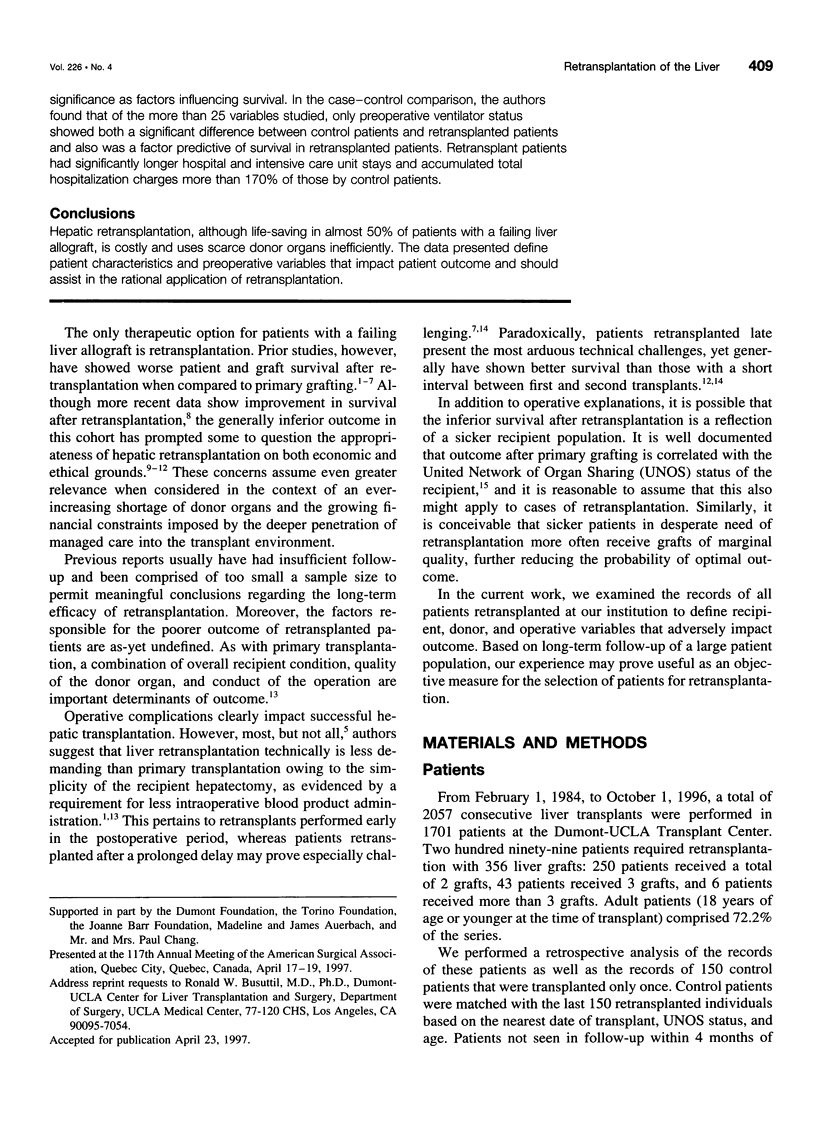
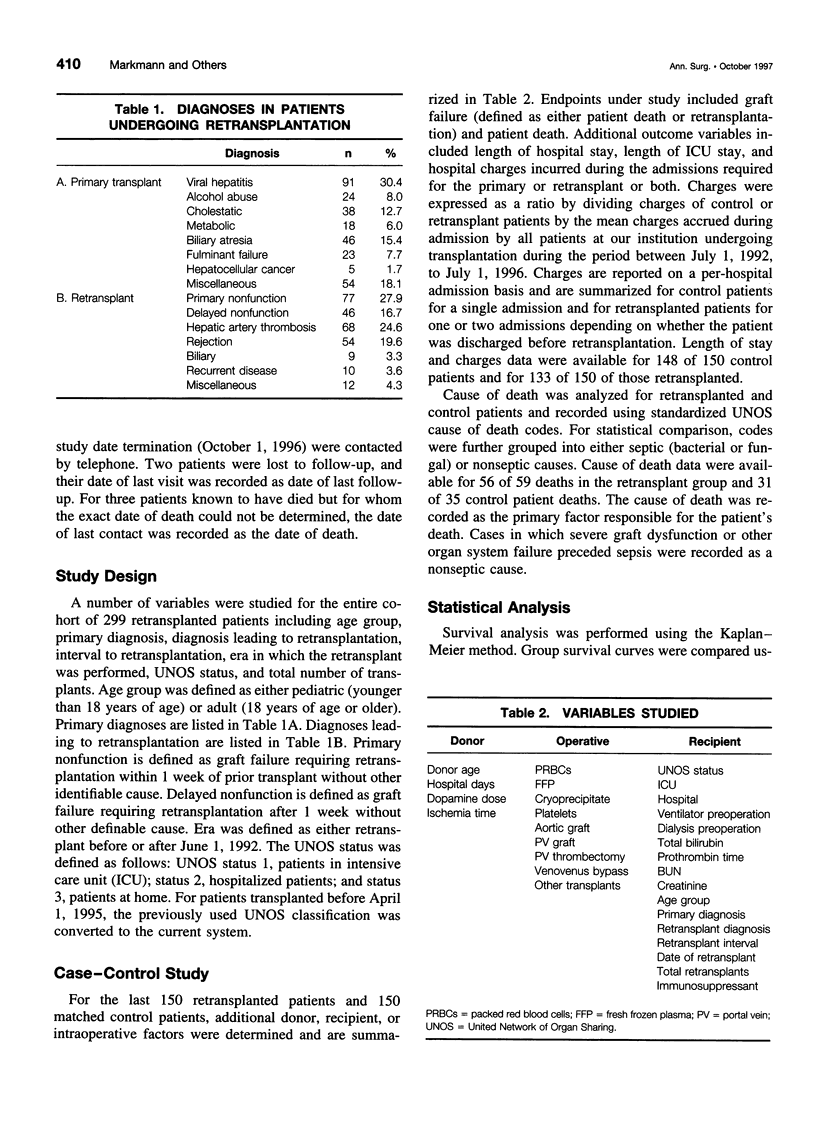




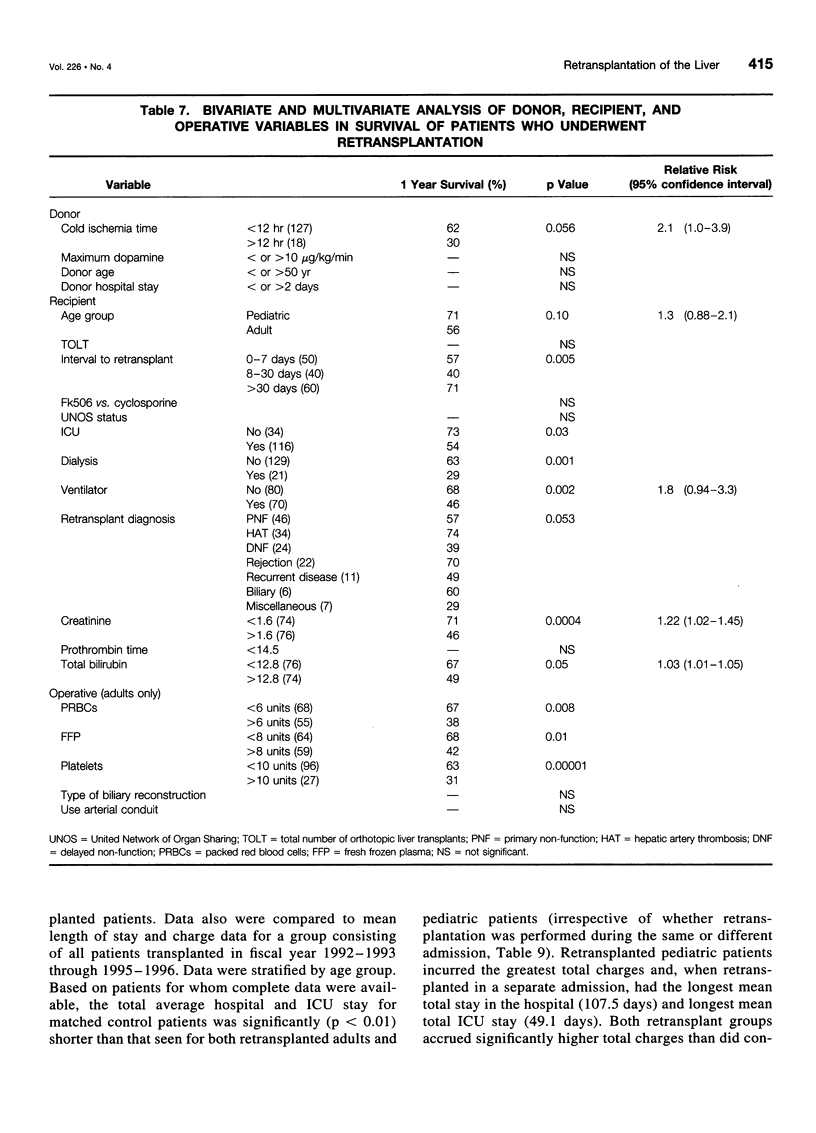

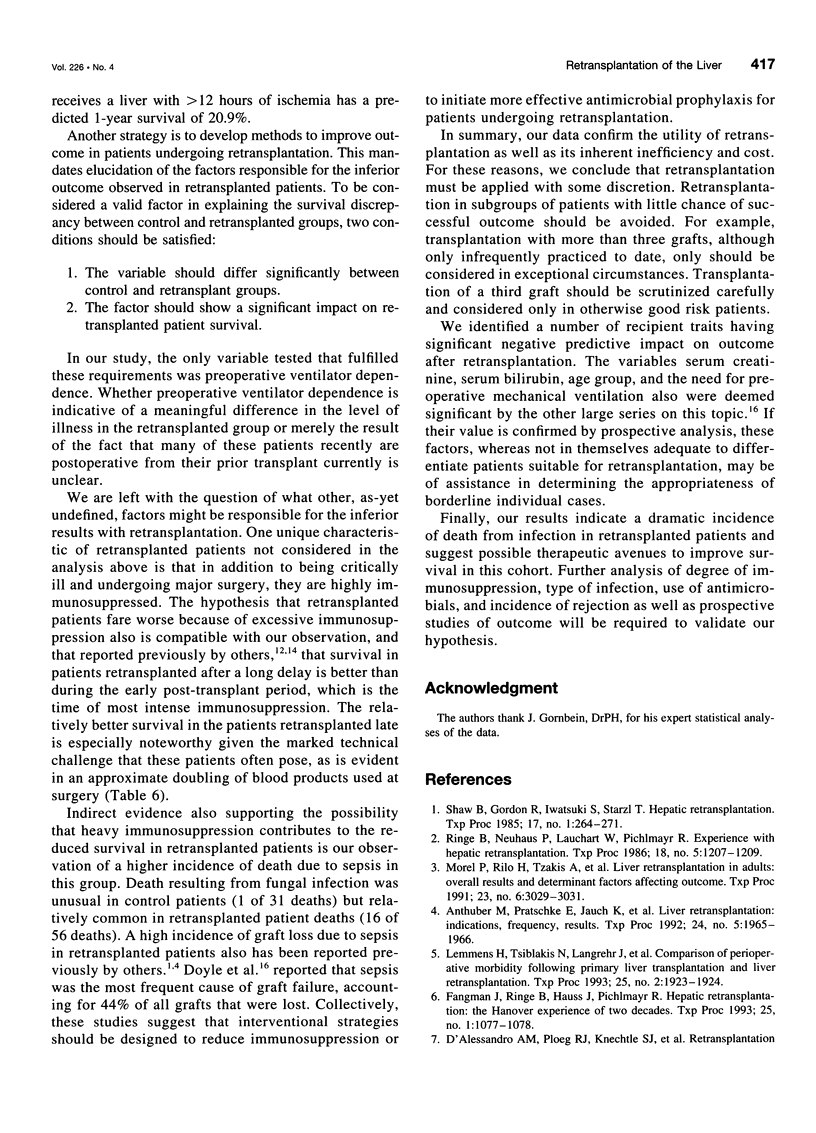
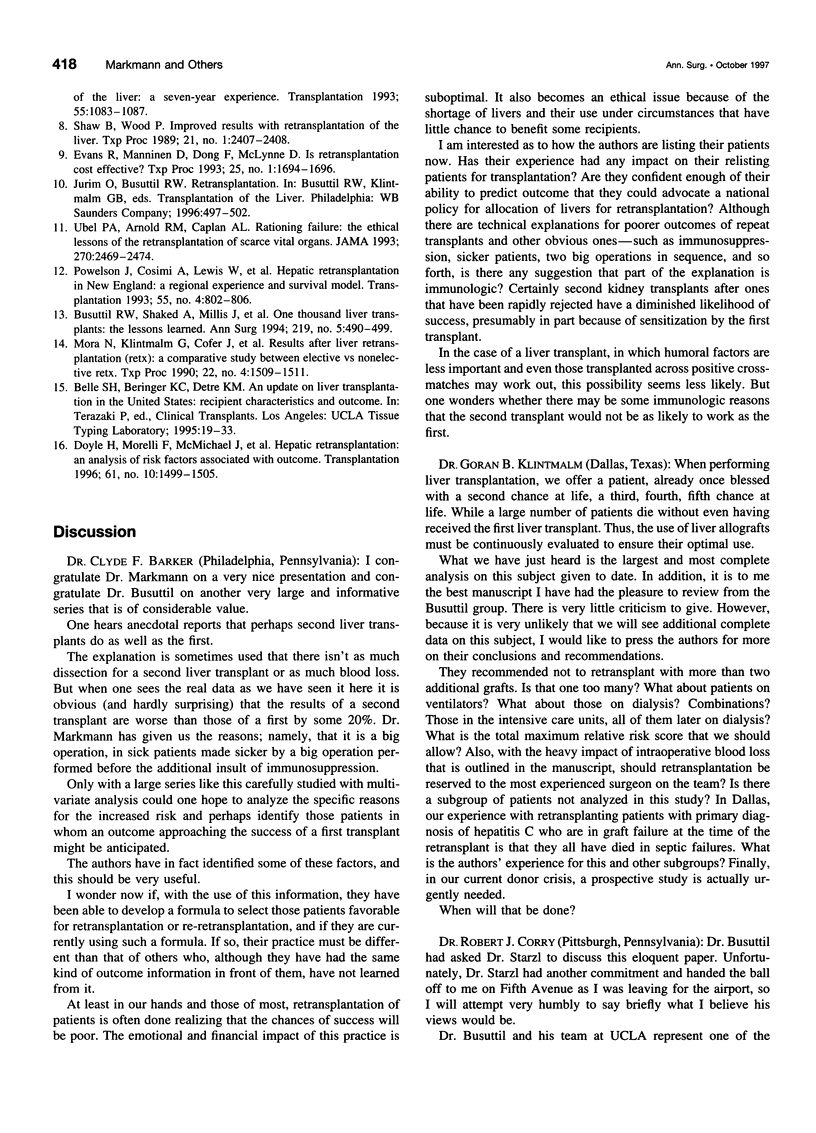
Selected References
These references are in PubMed. This may not be the complete list of references from this article.
- Anthuber M., Pratschke E., Jauch K. W., Zuelke C., Groh J., Welte M., Forst H. Liver retransplantation--indications, frequency, results. Transplant Proc. 1992 Oct;24(5):1965–1966. [PubMed] [Google Scholar]
- Belle S. H., Beringer K. C., Detre K. M. An update on liver transplantation in the United States: recipient characteristics and outcome. Clin Transpl. 1995:19–33. [PubMed] [Google Scholar]
- Busuttil R. W., Shaked A., Millis J. M., Jurim O., Colquhoun S. D., Shackleton C. R., Nuesse B. J., Csete M., Goldstein L. I., McDiarmid S. V. One thousand liver transplants. The lessons learned. Ann Surg. 1994 May;219(5):490–499. doi: 10.1097/00000658-199405000-00007. [DOI] [PMC free article] [PubMed] [Google Scholar]
- D'Alessandro A. M., Ploeg R. J., Knechtle S. J., Pirsch J. D., Stegall M. D., Hoffmann R., Sollinger H. W., Belzer F. O., Kalayoglu M. Retransplantation of the liver--a seven-year experience. Transplantation. 1993 May;55(5):1083–1087. doi: 10.1097/00007890-199305000-00028. [DOI] [PubMed] [Google Scholar]
- Doyle H. R., Morelli F., McMichael J., Doria C., Aldrighetti L., Starzl T. E., Marino I. R. Hepatic Retransplantation--an analysis of risk factors associated with outcome. Transplantation. 1996 May 27;61(10):1499–1505. doi: 10.1097/00007890-199605270-00016. [DOI] [PMC free article] [PubMed] [Google Scholar]
- Evans R. W., Manninen D. L., Dong F. B., McLynne D. A. Is retransplantation cost effective? Transplant Proc. 1993 Feb;25(1 Pt 2):1694–1696. [PubMed] [Google Scholar]
- Fangmann J., Ringe B., Hauss J., Pichlmayr R. Hepatic retransplantation: the Hannover experience of two decades. Transplant Proc. 1993 Feb;25(1 Pt 2):1077–1078. [PubMed] [Google Scholar]
- Lemmens H. P., Tsiblakis N., Langrehr J. M., Blumhardt G., Lohmann R., Keck H., Neuhaus P. Comparison of perioperative morbidity following primary liver transplantation and liver retransplantation. Transplant Proc. 1993 Apr;25(2):1923–1924. [PubMed] [Google Scholar]
- Mora N. P., Klintmalm G. B., Cofer J. B., Poplawski S. S., Goldstein R. M., Gonwa T. A., Husberg B. S. Results after liver retransplantation (RETx): a comparative study between "elective" vs "nonelective" RETx. Transplant Proc. 1990 Aug;22(4):1509–1511. [PubMed] [Google Scholar]
- Morel P., Rilo H. L., Tzakis A. G., Todo S., Gordon R. D., Starzl T. E. Liver retransplantation in adults: overall results and determinant factors affecting the outcome. Transplant Proc. 1991 Dec;23(6):3029–3031. [PMC free article] [PubMed] [Google Scholar]
- Powelson J. A., Cosimi A. B., Lewis W. D., Rohrer R. J., Freeman R. B., Vacanti J. P., Jonas M., Lorber M. I., Marks W. H., Bradley J. Hepatic retransplantation in New England--a regional experience and survival model. Transplantation. 1993 Apr;55(4):802–806. doi: 10.1097/00007890-199304000-00023. [DOI] [PubMed] [Google Scholar]
- Shaw B. W., Jr, Wood R. P. Improved results with retransplantation of the liver. Transplant Proc. 1989 Feb;21(1 Pt 2):2407–2408. [PubMed] [Google Scholar]
- Ubel P. A., Arnold R. M., Caplan A. L. Rationing failure. The ethical lessons of the retransplantation of scarce vital organs. JAMA. 1993 Nov 24;270(20):2469–2474. doi: 10.1001/jama.270.20.2469. [DOI] [PubMed] [Google Scholar]


